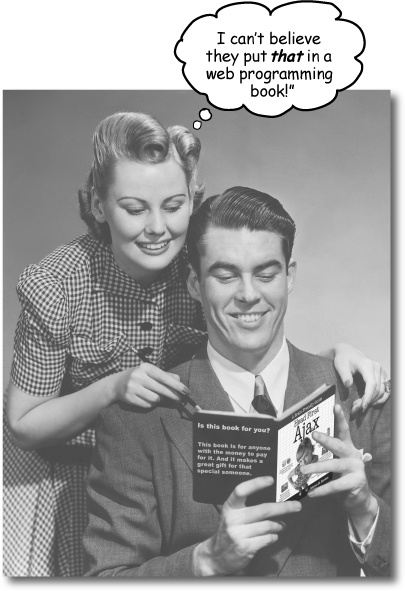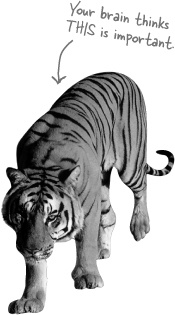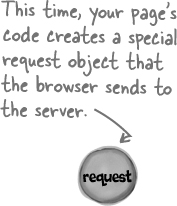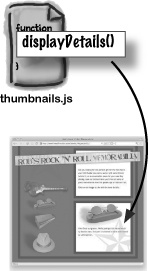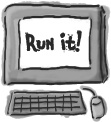If you can answer “yes” to all of these:
Do you know HTML, some CSS, and some JavaScript? (You don’t need to be a guru or anything.)
Do you want to learn, understand, and remember Ajax, with a goal of developing responsive and usable web applications?
Do you prefer stimulating dinner party conversation to dry, dull, academic lectures?
this book is for you.
If you can answer “yes” to any one of these:
Are you completey new to HTML or CSS or JavaScript? (You don’t need to be advanced, but you should definitely have some experience. If not, go get a copy of Head First HTML and CSS, today, and then come back and get this book.)
Are you a kick-butt Ajax or web developer looking for a reference book?
Are you afraid to try something different? Would you rather have a root canal than mix stripes with plaid? Do you believe that a technical book can’t be serious if servers and web browsers are anthropomorphized?
this book is not for you.
“How can this be a serious book on web programming?”
“What’s with all the graphics?”
“Can I actually learn it this way?”
Your brain craves novelty. It’s always searching, scanning, waiting for something unusual. It was built that way, and it helps you stay alive.
So what does your brain do with all the routine, ordinary, normal things you encounter? Everything it can to stop them from interfering with the brain’s real job—recording things that matter. It doesn’t bother saving the boring things; they never make it past the “this is obviously not important” filter.
How does your brain know what’s important? Suppose you’re out for a day hike and a tiger jumps in front of you, what happens inside your head and body?
Neurons fire. Emotions crank up. Chemicals surge.
And that’s how your brain knows...
This must be important! Don’t forget it!
But imagine you’re at home, or in a library. It’s a safe, warm, tiger-free zone. You’re studying. Getting ready for an exam. Or trying to learn some tough technical topic your boss thinks will take a week, ten days at the most.
Just one problem. Your brain’s trying to do you a big favor. It’s trying to make sure that this obviously non-important content doesn’t clutter up scarce resources. Resources that are better spent storing the really big things. Like tigers. Like the danger of fire. Like how you should never have posted those “party” photos on your Facebook page.
And there’s no simple way to tell your brain, “Hey brain, thank you very much, but no matter how dull this book is, and how little I’m registering on the emotional Richter scale right now, I really do want you to keep this stuff around.”
If you really want to learn, and you want to learn more quickly and more deeply, pay attention to how you pay attention. Think about how you think. Learn how you learn.
Most of us didn’t take courses on metacognition or learning theory when we were growing up. We were expected to learn, but rarely taught to learn.
But we assume that if you’re holding this book, you really want to learn Ajax and web programming. And you probably don’t want to spend a lot of time. If you want to use what you read in this book, you need to remember what you read. And for that, you’ve got to understand it. To get the most from this book, or any book or learning experience, take responsibility for your brain. Your brain on this content.
The trick is to get your brain to see the new material you’re learning as Really Important. Crucial to your well-being. As important as a tiger. Otherwise, you’re in for a constant battle, with your brain doing its best to keep the new content from sticking.
So just how DO you get your brain to treat web programming like it was a hungry tiger?
There’s the slow, tedious way, or the faster, more effective way. The slow way is about sheer repetition. You obviously know that you are able to learn and remember even the dullest of topics if you keep pounding the same thing into your brain. With enough repetition, your brain says, “This doesn’t feel important to him, but he keeps looking at the same thing over and over and over, so I suppose it must be.”
The faster way is to do anything that increases brain activity, especially different types of brain activity. The things on the previous page are a big part of the solution, and they’re all things that have been proven to help your brain work in your favor. For example, studies show that putting words within the pictures they describe (as opposed to somewhere else in the page, like a caption or in the body text) causes your brain to try to makes sense of how the words and picture relate, and this causes more neurons to fire. More neurons firing = more chances for your brain to get that this is something worth paying attention to, and possibly recording.
A conversational style helps because people tend to pay more attention when they perceive that they’re in a conversation, since they’re expected to follow along and hold up their end. The amazing thing is, your brain doesn’t necessarily care that the “conversation” is between you and a book! On the other hand, if the writing style is formal and dry, your brain perceives it the same way you experience being lectured to while sitting in a roomful of passive attendees. No need to stay awake.
But pictures and conversational style are just the beginning...
We used pictures, because your brain is tuned for visuals, not text. As far as your brain’s concerned, a picture really is worth a thousand words. And when text and pictures work together, we embedded the text in the pictures because your brain works more effectively when the text is within the thing the text refers to, as opposed to in a caption or buried in the text somewhere.
We used redundancy, saying the same thing in different ways and with different media types, and multiple senses, to increase the chance that the content gets coded into more than one area of your brain.
We used concepts and pictures in unexpected ways because your brain is tuned for novelty, and we used pictures and ideas with at least some emotional content, because your brain is tuned to pay attention to the biochemistry of emotions. That which causes you to feel something is more likely to be remembered, even if that feeling is nothing more than a little humor, surprise, or interest.
We used a personalized, conversational style, because your brain is tuned to pay more attention when it believes you’re in a conversation than if it thinks you’re passively listening to a presentation. Your brain does this even when you’re reading.
We included more than 80 activities, because your brain is tuned to learn and remember more when you do things than when you read about things. And we made the exercises challenging-yet-do-able, because that’s what most people prefer.
We used multiple learning styles, because you might prefer step-by-step procedures, while someone else wants to understand the big picture first, and someone else just wants to see an example. But regardless of your own learning preference, everyone benefits from seeing the same content represented in multiple ways.
We include content for both sides of your brain, because the more of your brain you engage, the more likely you are to learn and remember, and the longer you can stay focused. Since working one side of the brain often means giving the other side a chance to rest, you can be more productive at learning for a longer period of time.
And we included stories and exercises that present more than one point of view, because your brain is tuned to learn more deeply when it’s forced to make evaluations and judgments.
We included challenges, with exercises, and by asking questions that don’t always have a straight answer, because your brain is tuned to learn and remember when it has to work at something. Think about it—you can’t get your body in shape just by watching people at the gym. But we did our best to make sure that when you’re working hard, it’s on the right things. That you’re not spending one extra dendrite processing a hard-to-understand example, or parsing difficult, jargon-laden, or overly terse text.
We used people. In stories, examples, pictures, etc., because, well, because you’re a person. And your brain pays more attention to people than it does to things.
So, we did our part. The rest is up to you. These tips are a starting point; listen to your brain and figure out what works for you and what doesn’t. Try new things.
Slow down. The more you understand, the less you have to memorize.
Don’t just read. Stop and think. When the book asks you a question, don’t just skip to the answer. Imagine that someone really is asking the question. The more deeply you force your brain to think, the better chance you have of learning and remembering.
Do the exercises. Write your own notes.
We put them in, but if we did them for you, that would be like having someone else do your workouts for you. And don’t just look at the exercises. Use a pencil. There’s plenty of evidence that physical activity while learning can increase the learning.
Read the “There are No Dumb Questions”
That means all of them. They’re not optional sidebars—they’re part of the core content! Don’t skip them.
Make this the last thing you read before bed. Or at least the last challenging thing.
Part of the learning (especially the transfer to long-term memory) happens after you put the book down. Your brain needs time on its own, to do more processing. If you put in something new during that processing time, some of what you just learned will be lost.
Drink water. Lots of it.
Your brain works best in a nice bath of fluid. Dehydration (which can happen before you ever feel thirsty) decreases cognitive function.
Talk about it. Out loud.
Speaking activates a different part of the brain. If you’re trying to understand something, or increase your chance of remembering it later, say it out loud. Better still, try to explain it out loud to someone else. You’ll learn more quickly, and you might uncover ideas you hadn’t known were there when you were reading about it.
Listen to your brain.
Pay attention to whether your brain is getting overloaded. If you find yourself starting to skim the surface or forget what you just read, it’s time for a break. Once you go past a certain point, you won’t learn faster by trying to shove more in, and you might even hurt the process.
Feel something.
Your brain needs to know that this matters. Get involved with the stories. Make up your own captions for the photos. Groaning over a bad joke is still better than feeling nothing at all.
Practice writing web applications!
There’s only one way to truly master web programming: program web applications. And that’s what you’re going to do throughout this book. Using Ajax is a skill, and the only way to get good at it is to practice. We’re going to give you a lot of practice: every chapter has apps that we’ll build. Don’t just skip over them—a lot of the learning happens when you build these apps yourself. And definitely make sure you understand what’s going on before you move on to the next part of the book.
This is a learning experience, not a reference book. We deliberately stripped out everything that might get in the way of learning whatever it is we’re working on at that point in the book. And the first time through, you need to begin at the beginning, because the book makes assumptions about what you’ve already seen and learned.
We assume you are familiar with HTML and CSS.
It would take an entire book to teach you HTML and CSS (in fact, that’s exactly what it took: Head First HTML with CSS & XHTML). We chose to focus this book on Ajax programming, rather than rehash lots of markup and style that you could learn about in other places.
We assume you’ve at least seen JavaScript code before.
It would take an entire book to teach you... oh, wait, we’ve already said that. Seriously, JavaScript is a lot more than a simple scripting language, and we aren’t going to cover all the ways you can use JavaScript in this book. You’ll learn about all the ways that JavaScript is related to Ajax programming, and learn how to use JavaScript extensively to add interaction to your web pages and make requests to a server.
However, if you’ve never written a line of JavaScript, aren’t at all familiar with functions or curly braces, or have never programmed in any language before, you might want to pick up a good JavaScript book and browse through it. If you want to plow into this book, feel free—but we will be moving fairly quickly over the basics.
We don’t cover server-side programming in this book.
It’s now common to find server-side programs written in Java, PHP, Ruby, Python, Perl, Ruby on Rails, C#, and a whole lot more. Ajax programming works with all of these languages, and we have tried to represent several of them in this book’s examples.
To keep you focused on learning Ajax, though, we do not spend much time explaining the server-side programs used; we’ll show you the basic inputs and outputs to the server, but that’s as far as we go. We believe that your Ajax applications can be written to work with any kind of server-side program; we also believe that you’re smart enough to apply the lessons learned from an example that uses PHP to one that uses Ruby on Rails or a Java servlet.
You can visit us online at http://www.headfirstlabs.com/books/hfajax to download sample server-side programs, so you can run these apps yourself.
We encourage you to use more than one browser with this book.
As much as it sucks, different web browsers handle your HTML, your CSS, and your JavaScript in completely different ways. If you want to be a complete Ajax programmer, you should always test your asynchronous applications on lots of modern browsers. All the examples in this book were tested on recent versions of Firefox, Opera, Safari, Internet Explorer, and Mozilla. If you find problems, though, let us know... we promise it’s an accident.
We often use tag names for element names.
Rather than saying “the a element,” or “the ‘a’ element,” we use a tag name, like “the <a> element.” While this may not be technically correct (because <a> is an opening tag, not a full blown element), it does make the text more readable.
The activities are NOT optional.
The exercises and activities are not add-ons; they’re part of the core content of the book. Some of them are to help with memory, some are for understanding, and some will help you apply what you’ve learned. Don’t skip the exercises.
The redundancy is intentional and important.
One distinct difference in a Head First book is that we want you to really get it. And we want you to finish the book remembering what you’ve learned. Most reference books don’t have retention and recall as a goal, but this book is about learning, so you’ll see many of the concepts come up more than once.
The examples are as lean as possible.
Our readers tell us that it’s frustrating to wade through 200 lines of an example looking for the two lines they need to understand. Most examples in this book are shown within the smallest possible context, so that the part you’re trying to learn is clear and simple. Don’t expect all of the examples to be robust, or even complete—they are written specifically for learning, and aren’t always fully functional.
We’ve placed all the example files on the Web so you can download them. You’ll find them at http://www.headfirstlabs.com/books/hfajax/.
The ‘Brain Power’ exercises don’t have answers.
For some of them, there is no right answer, and for others, part of the learning experience of the Brain Power activities is for you to decide if and when your answers are right. In some of the Brain Power exercises you will find hints to point you in the right direction.
Technical Reviewers:
Bear Bibeault is a Web Applications Architect responsible for an enterprise financial application used by the accountants that many of the Fortune 500 companies keep in their dungeons. He also delights clients with web applications he creates on the side (Ajax-powered, of course), and serves as a sheriff (senior moderator) at JavaRanch.com.
Anthony T. Holdener III is the Director of Information Technology for Korein Tillery, LLC, but was a web applications developer in his previous life as a programmer; he is also the author of Ajax: The Definitive Guide (O’Reilly).
Elaine Nelson has been designing websites for nearly 10 years. As she tells her mother, an English degree comes in handy everywhere. Elaine’s current musings and obsessions can be found at elainenelson.org.
Pauline McNamara is involved in e-learning development and support at the Center for New Technologies and Education at Fribourg University in Switzerland.
Andrew Monkhouse is an administrator on JavaRanch, and a Java developer by day. He is currently working for PersonalShopper.com in the USA - a long way from his home in Australia.
Fletcher Moore did all our code samples and was indispensable to the project. He is a web developer and designer at Georgia Tech. In his spare time he’s an avid cyclist, musician, gardener, and Red Sox fan. He resides in Atlanta with his wife Katherine, daughter Sailor, and son Satchel.
My support team:
Even beyond the fantastic technical reviewers, this book wouldn’t have seen the light of day were it not for my own little technical support team. Stephen Jeffries, developer extraordinaire, helped out with the server-side code and reviewed all the samples before submission. Michael Morrison is the world’s best sounding board for those middle-of-the-night, “Why does this code work everywhere but in this browser?” questions. And John Hardesty provided the basic algorithms for several of the games you’ll be building. (He’s also my brother, which I’ve always thought was pretty cool. But don’t tell him I said so.)
My editor:
The greatest gift any editor can give a writer is to say, “This isn’t working, this is why, and this is what I think you should do about it.” Brett McLaughlin came through every damn time, and for that I will always be grateful.
The O’Reilly team:
I’d also like to thank Laurie Petrycki for being the voice of reason in the always-insane world of technical publishing, and both Louise Barr and Sanders Kleinfeld for fielding even the wildest InDesign questions with patience and grace.
 When you see a Safari® icon on the cover of your favorite technology book that means the book is available online through the O’Reilly Network Safari Bookshelf.
When you see a Safari® icon on the cover of your favorite technology book that means the book is available online through the O’Reilly Network Safari Bookshelf.
Safari offers a solution that’s better than e-books. It’s a virtual library that lets you easily search thousands of top tech books, cut and paste code samples, download chapters, and find quick answers when you need the most accurate, current information. Try it for free at http://safari.oreilly.com.
Get Head First Ajax now with the O’Reilly learning platform.
O’Reilly members experience books, live events, courses curated by job role, and more from O’Reilly and nearly 200 top publishers.
